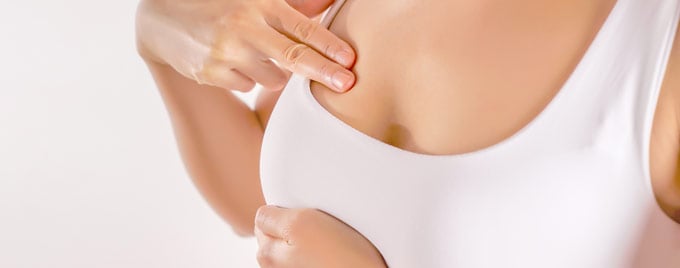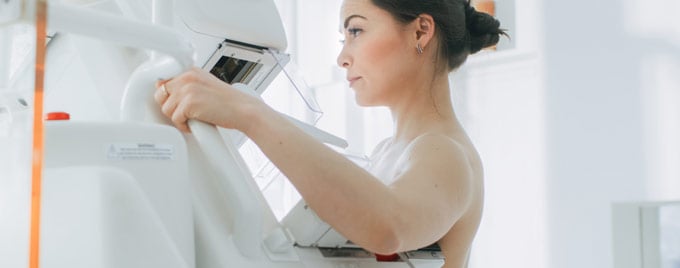Breast cancer is the most common cancer in women. There are about 55,000 cases in the UK each year and about one in seven women will develop it during their lifetime.
The survival rate for breast cancer is relatively good, with almost nine in 10 people living for at least five years after being diagnosed. It’s important to detect it early to give you the best chance of recovering, which is why breast cancer screening is important.
What is breast cancer?
Cancers start when abnormal cells in your body grow uncontrollably. Breast cancer is caused by this happening in your breast tissue, causing a growth (tumour) to form. It can happen to men too, but this is rare. It usually begins in the cells around the milk ducts.
Breast cancer risk factors include family history, age, obesity and smoking. You also have a higher risk if you have a late menopause or you started your periods before the age of 12 — this is because you’ll have had higher oestrogen levels in your body over a longer period of time.
The main symptoms of breast cancer are:
- A lump or thickening in your breast or under your armpit
- A rash around your nipple
- Change in the size or appearance of your breast
- Leaking from your nipple that isn’t breast milk
- Pain in or around your breast
- Puckering of the skin in your breast
Spotting early signs
Spotting the early signs of breast cancer is important to give you the best chance of recovery.
In cases where it’s caught in its earliest stages, all people survive for more than one year after diagnosis and 98% survive for five years. However, in cases when it’s caught at the latest stage, only one in four people survive for another five years after diagnosis.
It’s important to get familiar with how your breasts normally look and feel at different times of the month. This will help you pick up any unusual changes quickly. If you do notice any changes, you should book an appointment to see your GP. Common breast cancer symptoms can also be signs of other less harmful conditions, but it’s important to get them checked.

Breast cancer screening
The UK NHS breast screening programme invites women aged between 50 and 70 to be screened for breast cancer every three years. The screening involves a breast X-ray, called a mammogram.
If you are concerned about breast cancer or are in a high-risk group (eg if you have a family history of breast cancer) you may want to be screened more frequently than once every three years. If you’re under 50, you might also want to be screened if one or more of the other risk factors apply to you.
You should also get screened as soon as possible if you notice any breast cancer symptoms so that treatment can start quickly if needed.
If you choose to have a mammogram with us you will be well looked after by a multidisciplinary team at every step of the way, including supporting you after the screening, if it’s needed.
What is a mammogram?
A mammogram is a type of X-ray. It can pick up changes in your breast tissue before you can see or feel the changes yourself. It’s one of the best ways of spotting breast cancer early and increases your chances of recovery.
A standard screening mammogram involves taking two X-rays of each breast. If you’ve already spotted possible signs of breast cancer, you might have a diagnostic screening that involves taking more X-rays. The mammogram will highlight any unusual growths in your breast and help your doctor work out what’s happening and the best course of treatment.
It will be carried out in a hospital by a specialist radiographer (someone who specialises in using X-rays to produce images of the human body).
Preparing for a mammogram
Before your mammogram, you’ll have a consultation to talk through your medical history, family history and any symptoms you have. Your radiographer will give you personalised advice so you know what to expect.
You will need to make sure that your underarms and breasts are clean and don’t have any lotions, antiperspirants or other products on them as they can affect the quality of the X-ray image.
What happens during a mammogram?
A mammogram uses a machine called a mammography unit. It’s specially designed for breast X-rays. Some people feel anxious or embarrassed about having one, but the reality is that it’s a simple process that’s over quickly.
Your radiographer will always be female and a well-trained professional. You will need to undress to the waist and your radiographer will carefully position your breast against the machine.
Because a mammogram is a low dose X-ray, your breast needs to be placed on a platform and gently but firmly compressed. This spreads the tissue apart and allows the X-ray to produce a better picture while using less radiation. Your breasts are checked one at a time and each one needs two scans. The whole process typically takes 30 minutes.

Compression and radiation
The compression and exposure to radiation can make people feel anxious about a mammogram, but it’s important not to let this stop you getting checked. If you do have early-stage breast cancer but you don’t find out quickly, the cancer may progress and reduce your chances of recovery.
It can feel uncomfortable when your breast is compressed by the machine. Each scan takes about one minute and you will have two scans on each breast. If it becomes too uncomfortable or you feel pain, tell your radiographer and she will do what she can to help.
The X-ray will also expose you to a small amount of radiation. However, the amount is very low and similar to the level you would be exposed to on a long-haul return flight.
Next steps
Today mammography machines are digital, and the X-ray images appear on a computer screen. Your doctor will review them as they appear to work out the next steps.
In the UK there is a national diagnostic system for reading mammograms provided by the Breast Imaging Reporting and Database System (BI-RADS).
BI-RADS grades breast lumps from zero to six — this indicates to your doctor what needs to be done next. The next steps can include more investigations, a biopsy or frequent screening to keep an eye on any abnormalities. If needed, a treatment plan will then be put together. Your doctor will discuss this, and any other care you might need, at your appointment.

